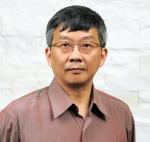13-atom metallic clusters studied by density functional theory: Dependence on exchange-correlation approximations and pseudopotentials
- Citation:
- Chou, J. P., Chen H. Y. T., Hsing C. R., Chang C. M., Cheng C., & Wei C. M. (2009). 13-atom metallic clusters studied by density functional theory: Dependence on exchange-correlation approximations and pseudopotentials. Physical Review B. 80, 10., Oct, Number 16
Abstract:
In this study, the 13-atom cluster structures of alkaline metals, alkaline-earth metals, boron group metals, carbon group metals, and 3d, 4d, and 5d transition metals in the periodic table are investigated by density functional theory with three kinds of exchange-correlation (XC) functionals: (i) local-density approximation (LDA); (ii) generalized gradient approximation (GGA) with Perdew-Wang 91; and (iii) generalized gradient approximation with Perdew-Burke-Ernzerhof. The dependence on pseudopotentials (PPs) with and without semicore electrons is also examined. The relative energies of five selected high-symmetry three-dimensional and four low-symmetry layer-type isomers for each element of interest are calculated and studied. Among the 44 metallic 13-atom clusters, our results show that the two GGA XC functionals have a great consistency; LDA and GGA results also reveal a great consistency, apart from the Cr, Mn, Fe, Co, Ni, and Rh 13-atom clusters, for which the results show a significant difference. Meanwhile, for most of the elements, the calculations with and without semicore PPs also produce consistent results, except for Cr, Mo, and V, which require a careful treatment of semicore states in the PPs.
Notes:
ISI Document Delivery No.: 513VLTimes Cited: 10Cited Reference Count: 37Cited References: Aguilera-Granja F, 2008, PHYS REV B, V78, DOI 10.1103/PhysRevB.78.134425 Aiken JD, 1999, J MOL CATAL A-CHEM, V145, P1, DOI 10.1016/S1381-1169(99)00098-9 Bae YC, 2004, PHYS REV B, V70, DOI 10.1103/PhysRevB.70.195413 Bae YC, 2005, PHYS REV B, V72, DOI 10.1103/PhysRevB.72.125427 Baletto F, 2005, REV MOD PHYS, V77, P371, DOI 10.1103/RevModPhys.77.371 BLOCHL PE, 1994, PHYS REV B, V50, P17953, DOI 10.1103/PhysRevB.50.17953 Bobadova-Parvanova P, 2003, PHYS REV A, V67, DOI 10.1103/PhysRevA.67.061202 Chang CM, 2004, PHYS REV LETT, V93, DOI 10.1103/PhysRevLett.93.133401 Cheng HS, 1996, PHYS REV LETT, V77, P51, DOI 10.1103/PhysRevLett.77.51 Futschek T, 2006, J PHYS-CONDENS MAT, V18, P9703, DOI 10.1088/0953-8984/18/42/016 Hakkinen H, 2000, PHYS REV B, V62, pR2287, DOI 10.1103/PhysRevB.62.R2287 Hakkinen H, 2002, PHYS REV LETT, V89, DOI 10.1103/PhysRevLett.89.033401 Hakkinen H, 2003, J PHYS CHEM A, V107, P6168, DOI 10.1021/jp035437i HOHENBERG P, 1964, PHYS REV B, V136, pB864, DOI 10.1103/PhysRev.136.B864 Hsing CR, 2009, PHYS REV B, V79, DOI 10.1103/PhysRevB.79.245401 Khanna SN, 2003, CHEM PHYS LETT, V378, P374, DOI 10.1016/S0009-2614(03)01235-1 KHANNA SN, 2003, QUANTUM PHENOMENA CL KOHN W, 1965, PHYS REV, V140, P1133 Kresse G, 1996, PHYS REV B, V54, P11169, DOI 10.1103/PhysRevB.54.11169 Kumar V, 2002, PHYS REV B, V66, DOI 10.1103/PhysRevB.66.144413 Kumar V, 2003, EUR PHYS J D, V24, P81, DOI 10.1140/epjd/e2003-00193-6 Kumar V, 2002, PHYS REV B, V65, DOI 10.1103/PhysRevB.65.125403 Longo RC, 2006, PHYS REV B, V74, DOI 10.1103/PhysRevB.74.193409 Nayak SK, 1998, CHEM PHYS LETT, V289, P473, DOI 10.1016/S0009-2614(98)00475-8 Oviedo J, 2002, J CHEM PHYS, V117, P9548, DOI 10.1063/1.1524154 Payne FW, 2006, PHYS REV LETT, V97, DOI 10.1103/PhysRevLett.97.193401 PERDEW JP, 1981, PHYS REV B, V23, P5048, DOI 10.1103/PhysRevB.23.5048 PERDEW JP, 1992, PHYS REV B, V46, P6671, DOI 10.1103/PhysRevB.46.6671 Perdew JP, 1996, PHYS REV LETT, V77, P3865, DOI 10.1103/PhysRevLett.77.3865 Rogan J, 2006, J CHEM PHYS, V125, DOI 10.1063/1.2402168 Sakurai M, 1999, J CHEM PHYS, V111, P235, DOI 10.1063/1.479268 Schmid G, 1999, CHEM SOC REV, V28, P179, DOI 10.1039/a801153b Service RF, 1996, SCIENCE, V271, P920, DOI 10.1126/science.271.5251.920 Sun Y, 2008, PHYS REV B, V77, DOI 10.1103/PhysRevB.77.075435 VANDERBILT D, 1990, PHYS REV B, V41, P7892, DOI 10.1103/PhysRevB.41.7892 Wang LL, 2005, J PHYS CHEM B, V109, P23113, DOI 10.1021/jp0555347 Wang LL, 2007, PHYS REV B, V75, DOI 10.1103/PhysRevB.75.235405Chou, J. P. Chen, H. Y. T. Hsing, C. R. Chang, C. M. Cheng, C. Wei, C. M.National Science Council of Taiwan [96-2628-M001-006-MY3]; National Center for Theoretical Sciences (NCTS); National Center for High-Performance Computing (NCHC) in TaiwanThis work was supported in part by the National Science Council of Taiwan under Grant No. 96-2628-M001-006-MY3. We also acknowledge the National Center for Theoretical Sciences (NCTS) and computing resources from the National Center for High-Performance Computing (NCHC) in Taiwan.AMER PHYSICAL SOCCOLLEGE PK

